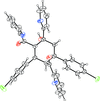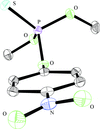issue contents
October 2014 issue

Cover illustration: Neutron diffraction data have been collected at 12, 50, 150 and 295 K for the dipeptide glycyl-L-alanine in order to obtain accurate positional and anisotropic displacement parameters for the H atoms. The values of these parameters serve as a benchmark for assessing the equivalent parameters obtained from a so-called Hirshfeld-atom refinement of X-ray diffraction data. See Capelli, Bürgi, Mason & Jayatilaka [Acta Cryst. (2014), C70, 949-952].
research papers


































 journal menu
journal menu

































